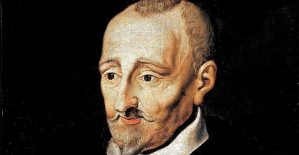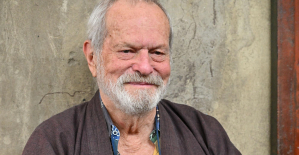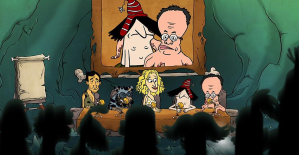For more than four decades, their graves lay right next to each other, in front of the altar of the gigantic cave church Basilica de Santa Cruz, about 45 kilometers north-west of Madrid: the mortal remains of José Antonio Primo de Rivera, the founder of the fascist movement Falange, were transferred here in 1959; the body of his successor Francisco Franco was buried by the Spaniards three days after his death in 1975 in a gigantic state funeral. It was only in 2019 that the bones of the longtime dictator were exhumed and buried in a family grave in a normal cemetery.
Of course, it's just a coincidence that Primo de Rivera and Franco died on the same date: November 20th. The Falangist leader was sentenced to death for treason and executed; the dictator was declared dead by his doctors after several heart attacks after days of no measurable activity in his brain.
The decades-long juxtaposition of the two graves was already a lie because Primo de Rivera thought little or nothing of Franco. In fact, relations between the two were never good. The Falangist chief had refused to list the general's name alongside his on a list of candidates; Franco did not forgive him for this attitude. But the death of Primo de Rivera enabled Franco to establish himself as leader of Spain's far-right extremists. This is how he rose to become the most successful fascist of all time.
The later dictator was born on December 4, 1892 into the family of a Spanish naval officer. His childhood was unhappy; his parents separated after a long argument when he was 14 years old. The boy also wanted to be an officer and attended the infantry academy in Toledo. His success was only manageable: he completed the basic course as only 251st out of 312 participants.
For this he distinguished himself in his first missions in Spanish colonies in North Africa. With merciless severity, he formed a unit of local mercenaries into a powerful force. In a battle with insurgents in 1916, he was critically injured and was considered a war hero from then on.
In the heated political strife in Spain in the early 1930s, Franco alternated his position between the monarchist wing and the rational republicans, who were willing to sacrifice the king in order to preserve as much of the established traditions as possible. But he turned relentlessly against the anarchists and socialists.
From 1934 Franco was chief of staff and thus supreme commander of the Spanish army. At the same time, the fascist Falange Primo de Riveras rose from being a splinter party to a force to be taken seriously. When in February 1936 the left forces of the Popular Front narrowly but unequivocally won the elections (with 4.65 to 4.5 million valid votes), this became the signal for the coup d'etat. On July 17, 1936, the uprising began, led by three generals, including Franco.
At the time, Primo de Rivera was already in prison for possession of a gun. From here, however, he openly confessed to the putschists and thus fulfilled the criminal offense of high treason. Apparently he hadn't expected that the takeover of power by the Catholic-conservative military would take too long.
In fact, however, a two-and-a-half-year, very cruel civil war began. The Popular Front, supported by Stalin's Soviet Union and International Brigades, committed numerous crimes against opponents and church officials, even nuns. The Franco troops, backed by Fascist Italy and Nazi Germany, were no better: they massacred en masse real or alleged leftists, who were often buried in pits on the edge of cemeteries or even just outside cemeteries walls.
The civil war in Spain developed into the first major proxy war in contemporary history. German aircraft from the Condor Legion bombed the small Basque town of Guernica in 1937. In May 1938, the Popular Front government in Madrid was practically finished and offered peace negotiations, but Franco insisted on total submission, so fighting continued. The civil war did not end until March 1939 when the Republicans collapsed. From then on, Francisco Franco was the undisputed ruler of Spain. In total, around half a million Spaniards died directly or indirectly in the civil war.
From then on Franco relied on the fascists, but integrated them into a larger movement that initially retained the name Falange. Although Hitler and Mussolini urged the Spaniards to enter World War II with them in 1940, the dictator essentially limited himself to nominal aid. In 1941 he sent a 17,500-strong volunteer force, mainly made up of particularly convinced Falange supporters, known as the "Blue Division", to the Eastern Front to support the Wehrmacht.
In 1943, the Western Allies put massive pressure on the dictator to reduce his support for Hitler's Germany. Franco officially disbanded the Blue Division, but a few thousand of the volunteers refused to return to Spain and continued fighting on their own. Eventually they were incorporated into the Waffen-SS.
In 1945/46 the USA, Great Britain and France urged Franco to resign, but Franco refused. From the end of 1947, the aggression of the Stalinist-dominated Eastern Bloc meant that the western powers had to accept – or more precisely: had to accept – Spain and its dictator as a partner in the Cold War. Franco admitted that at a later date the monarchy in Spain would be restored. However, he did everything to stabilize his own regime by means of a personality cult around Primo de Rivera, called “the absent one”, and himself.
After a quarter of a century of rule, which was characterized by political bondage as well as economic boom, Francisco Franco officially died on November 20, 1975. His successor as head of state was King Juan Carlos I. He wanted to draw a "line" under the Franco era - a An undertaking that was bound to fail in view of the many victims.
The coming to terms with the tyranny of the Spanish fascists only got underway decades later. To this day, the Spanish conservatives have not been able to free themselves from the shadow of the dictator. So it took years until the unworthy place of homage to Franco in the Basilica de Santa Cruz could be removed. The Franco family staged the reburial to the best of their ability.
You can also find "World History" on Facebook. We are happy about a like.

 United States: divided on the question of presidential immunity, the Supreme Court offers respite to Trump
United States: divided on the question of presidential immunity, the Supreme Court offers respite to Trump Maurizio Molinari: “the Scurati affair, a European injury”
Maurizio Molinari: “the Scurati affair, a European injury” Hamas-Israel war: US begins construction of pier in Gaza
Hamas-Israel war: US begins construction of pier in Gaza Israel prepares to attack Rafah
Israel prepares to attack Rafah First three cases of “native” cholera confirmed in Mayotte
First three cases of “native” cholera confirmed in Mayotte Meningitis: compulsory vaccination for babies will be extended in 2025
Meningitis: compulsory vaccination for babies will be extended in 2025 Spain is the country in the European Union with the most overqualified workers for their jobs
Spain is the country in the European Union with the most overqualified workers for their jobs Parvovirus alert, the “fifth disease” of children which has already caused the death of five babies in 2024
Parvovirus alert, the “fifth disease” of children which has already caused the death of five babies in 2024 Falling wings of the Moulin Rouge: who will pay for the repairs?
Falling wings of the Moulin Rouge: who will pay for the repairs? “You don’t sell a company like that”: Roland Lescure “annoyed” by the prospect of a sale of Biogaran
“You don’t sell a company like that”: Roland Lescure “annoyed” by the prospect of a sale of Biogaran Insults, threats of suicide, violence... Attacks by France Travail agents will continue to soar in 2023
Insults, threats of suicide, violence... Attacks by France Travail agents will continue to soar in 2023 TotalEnergies boss plans primary listing in New York
TotalEnergies boss plans primary listing in New York La Pléiade arrives... in Pléiade
La Pléiade arrives... in Pléiade In Japan, an animation studio bets on its creators suffering from autism spectrum disorders
In Japan, an animation studio bets on its creators suffering from autism spectrum disorders Terry Gilliam, hero of the Annecy Festival, with Vice-Versa 2 and Garfield
Terry Gilliam, hero of the Annecy Festival, with Vice-Versa 2 and Garfield François Hollande, Stéphane Bern and Amélie Nothomb, heroes of one evening on the beach of the Cannes Film Festival
François Hollande, Stéphane Bern and Amélie Nothomb, heroes of one evening on the beach of the Cannes Film Festival Skoda Kodiaq 2024: a 'beast' plug-in hybrid SUV
Skoda Kodiaq 2024: a 'beast' plug-in hybrid SUV Tesla launches a new Model Y with 600 km of autonomy at a "more accessible price"
Tesla launches a new Model Y with 600 km of autonomy at a "more accessible price" The 10 best-selling cars in March 2024 in Spain: sales fall due to Easter
The 10 best-selling cars in March 2024 in Spain: sales fall due to Easter A private jet company buys more than 100 flying cars
A private jet company buys more than 100 flying cars This is how housing prices have changed in Spain in the last decade
This is how housing prices have changed in Spain in the last decade The home mortgage firm drops 10% in January and interest soars to 3.46%
The home mortgage firm drops 10% in January and interest soars to 3.46% The jewel of the Rocío de Nagüeles urbanization: a dream villa in Marbella
The jewel of the Rocío de Nagüeles urbanization: a dream villa in Marbella Rental prices grow by 7.3% in February: where does it go up and where does it go down?
Rental prices grow by 7.3% in February: where does it go up and where does it go down? Even on a mission for NATO, the Charles-de-Gaulle remains under French control, Lecornu responds to Mélenchon
Even on a mission for NATO, the Charles-de-Gaulle remains under French control, Lecornu responds to Mélenchon “Deadly Europe”, “economic decline”, immigration… What to remember from Emmanuel Macron’s speech at the Sorbonne
“Deadly Europe”, “economic decline”, immigration… What to remember from Emmanuel Macron’s speech at the Sorbonne Sale of Biogaran: The Republicans write to Emmanuel Macron
Sale of Biogaran: The Republicans write to Emmanuel Macron Europeans: “All those who claim that we don’t need Europe are liars”, criticizes Bayrou
Europeans: “All those who claim that we don’t need Europe are liars”, criticizes Bayrou These French cities that will boycott the World Cup in Qatar
These French cities that will boycott the World Cup in Qatar Medicine, family of athletes, New Zealand…, discovering Manae Feleu, the captain of the Bleues
Medicine, family of athletes, New Zealand…, discovering Manae Feleu, the captain of the Bleues Football: OM wants to extend Leonardo Balerdi
Football: OM wants to extend Leonardo Balerdi Six Nations F: France-England shatters the attendance record for women’s rugby in France
Six Nations F: France-England shatters the attendance record for women’s rugby in France Judo: eliminated in the 2nd round of the European Championships, Alpha Djalo in full doubt
Judo: eliminated in the 2nd round of the European Championships, Alpha Djalo in full doubt


















